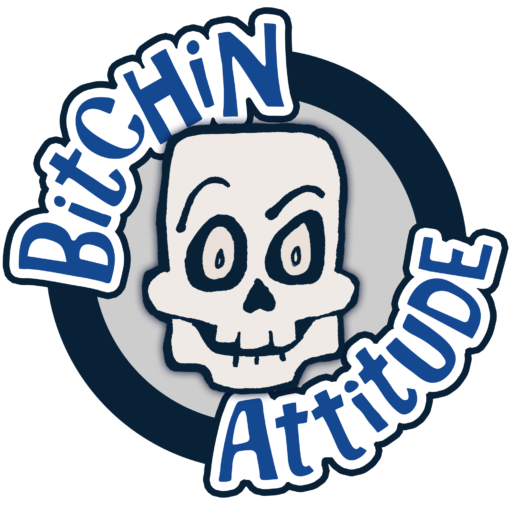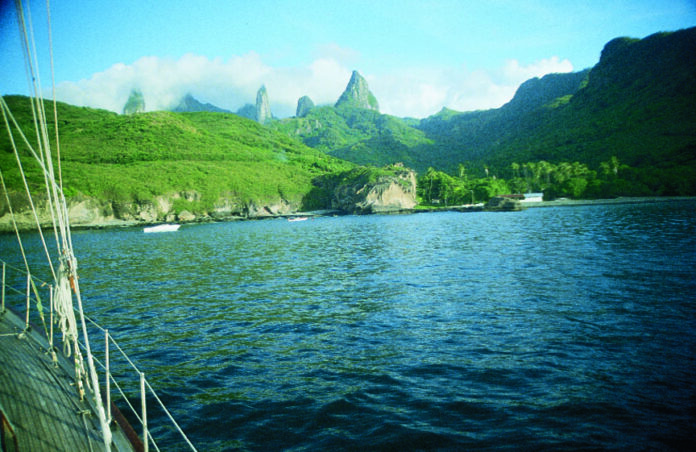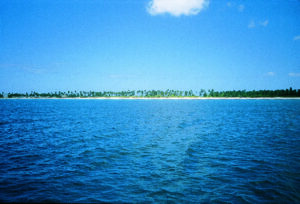We were finishing a 500-mile crossing that had been one for the books: four days and three nights of a 15-knot wind off our stern at about 120 degrees. We never even had to change our sails, except a few times when we wanted to go a little faster and ran our spinnaker. We were about 30 miles off Manihi, which has its highest point at about 60 feet. And that’s the top of a palm tree. The first one to spot it got a cold beer . . . so I went topside.
Andy got the beer. He climbed the mast about 15 miles from the island and spotted it. As we got closer, we saw it was just like we’d been told it would be. Just a white sandy beach surrounding a blue lagoon. Getting into it was a lot of fun. As we found out later, we were real lucky. We entered the pass, at high tide, just by accident. As we got through the end of the pass our depth sounder was reading 7’6”. Since our hull is eight-foot deep, that’s enough to put the fear of God into an atheist.
We worked our way over to a small motu of white sand and palm trees. We were all anxious to get the hook set and go for a swim, and to explore the motu. Andy and John swam off to a small bay, while Jody, Neil and I swam straight into the beach.
As we walked this most beautiful motu, picking up shells and just kind of marveling at the fact that places like this still exist, we heard a shout from Andy and John.
I didn’t know if they were being attacked by sharks, or being attacked by the natives. We ran toward their direction, and John was running in front, waving something at us.
It was a prop for a 25 horsepower Johnson outboard, which is what we’d been searching for over a month. He’d kicked it as he was going ashore. The prop was a little tweaked, but the rubber bushing was good. We rushed out to put it on, and the dinghy worked fine. We had a functioning dinghy once again.
We hoisted anchor a little later and headed over to a small picturesque hotel. Small white cabins sitting on stilts with blue roofs over crystal clear waters. This place was right out of a travel brochure. After downing a breakfast that someone else cooked, we decided we could put up with a little schmaltz for awhile. For the next two days, we ate hotel food, used hotel docks, and generally made like hotel guests. When we left we were presented a genuine hotel bill, for about $500, and that was just for food and our bar tab. The bill was taped to our refrigerator to remind us to eat on board. But as we were anchored in the next little motu called Ahe, about five miles south, the shock of the bill had passed. Once again we were anchored in a paradise.
Ahe is a smaller atoll, about four miles in diameter. It’s a strip of white sand with palm trees surrounding a multicolored blue lagoon. Getting in was a little hairy, as the entrance was six feet deep over the bar, with just a very small, maybe 10-foot area, that was eight feet deep. The water was like crystal, and the beach pure white sand, so we went for it. Once in we worked our way into a tight little anchorage. We went ashore when we got the anchor set, cracked a coconut, and toasted the most beautiful island we’d seen. Of course, since we were anchored among a bunch of coral heads, I planned to sleep like a long-tailed cat in a roomful of rocking chairs.
Aaaagghh!!! There are SHARKS out there! Yeah, I meant to use all capital letters, because these were capital-sized grey sharks. John, Jody, and I went out with the dinghy to do a drift-dive in the pass. That’s where you dinghy out to the far end of a pass and jump in, letting the current take you through the beauty of the reef. As we drifted through the pass into the lagoon, we started to see some sharks. No big deal as we’d been swimming with white tip, black tip and nurse sharks since we’d been in the islands. We were kind of used to them. But all of a sudden we started to see real, man-eater types.
At first there was just one or two coming out of the depths at the end of the pass. By the time there were seven in view, I was climbing into the dinghy, with John right behind. Jody was about 30 feet away, and was not moving. She was frozen by the sight of the sharks coming up at her. We motored over and I pulled her out just before the sharks reached her. Then, just to show what dunderheads we really are, we decided to shoot the other side of the pass. Brilliant, ain’t we? On the second pass we all hung pretty tight to the dinghy as we drifted through the clear waters. Near the end of the pass we saw about eight or nine large sharks near the bottom again, so Jody and I were in the boat about as fast as a rabbit running from a forest fire. John, being British, and trying to be cool, kind of hung there . . . until he turned around and saw about ten more rising up to him. At that point he was also making like he had ants in his skivvies. In all we counted twenty sharks before we left the area for good!
The best laid plans of mice and men oft go astray, and so it was with our departure from Ahe. It began in the afternoon when the wind started to come up, and all of a sudden, the cute anchorage with all the nice dive spots turned into the anchorage from hell, with coral heads all around trying to take bites out of our hull. As the wind built, we hurried to haul anchor, and just barely got out before we would have drifted onto one of the larger and sharper coral heads. We found our way out of the anchorage and headed across the lagoon to the pass. We searched for the deepest part of the entrance with John and Neil on the bow. They watched for coral heads or low water. They watched as we entered the pass. They watched as we headed over the low bar. They watched as we headed onto a reef, and they watched as we went aground!
It seems they were discussing if it was deep enough before telling me they weren’t sure. It wasn’t. We hit. Hard! The current helped to push us over the bar and dragged us clear, taking about an inch of fiberglass off the bottom of the keel. There is nothing quite like the feel of your boat heeled over 15 degrees and the sound and feel of coral dragging across the hull. The rudder didn’t touch, and after we were out of the pass everything seemed to work okay, so we headed toward Rangiroa.
By 3:30 a.m. we were off the entrance of Rangiroa bouncing around in a storm. Now I like entering a strange anchorage at night about as much as Zsa Zsa likes Beverly Hills cops, so we tacked back and forth for the next two hours waiting for daylight.
Rangiroa is as pretty as the other Tuamotu islands. There are about 200 shades of blue in the water, and the anchorage is well protected. It is the third largest atoll in the world, 40 miles long and 26 miles wide. We ran into a couple of crew members, one from Denmark and the other from San Francisco, who needed to go to Papeete. We offered them a ride, and took off after a couple of days when the winds subsided.
Huahine was an overnight sail from Moorea. The first few hours of the overnight, 85-mile passage went as smooth as a frog’s hair. Eight to ten knots of wind off our beam driving us at six knots. Then, as usual, Mother Nature decided she’d like to give us a bit of grief, so she did, in the form of a squall. It lasted all night with heavy rains and winds up to 40 knots. Just about as much fun as passing peach pits! At dawn we were about five miles from Huahine and were glad to get in and anchor.
The next evening, Andy and John decided they would try to drink the island of Huahine dry. Before they did, they became intoxicated enough to run the inflatable up on a reef until it dug an 18-inch hole in the bottom. When they reached the boat they were knee-deep in water, and couldn’t figure why. Then Andy dropped the handheld radio. In a matter of a few minutes, my $5,000 dinghy and $350 radio were history.
We awoke this morning in Huahine and realized that Andy had left the boat during the night. He had taken a return ticket I had bought as a bond that was needed for each crew member, packed his bag and never even said goodbye. After the ripped dinghy and dropped radio, I guess he felt bad.




